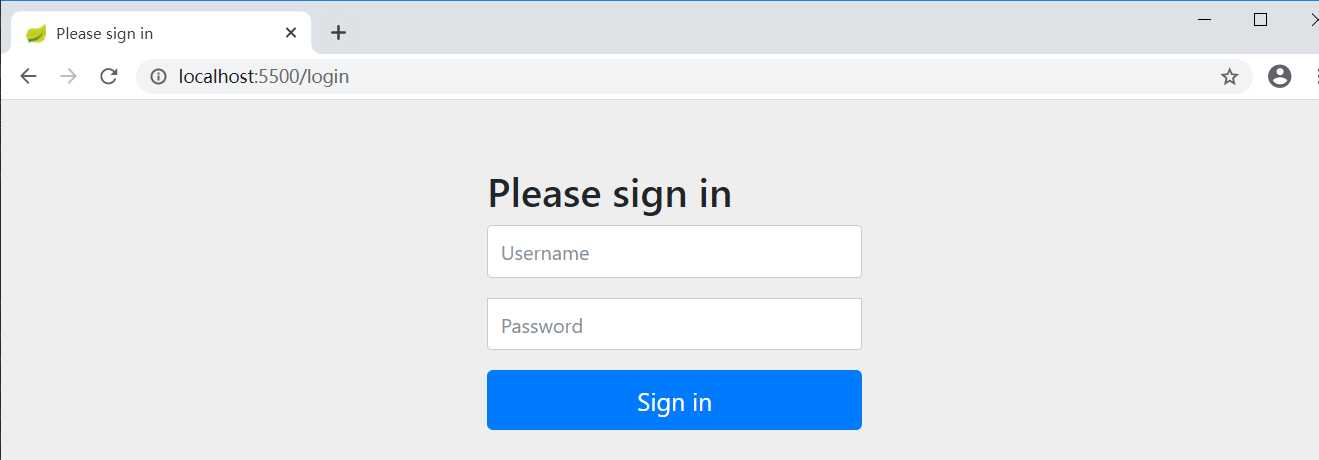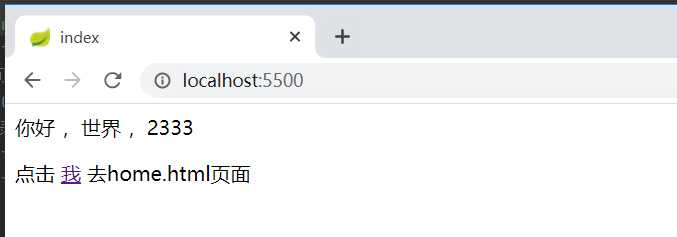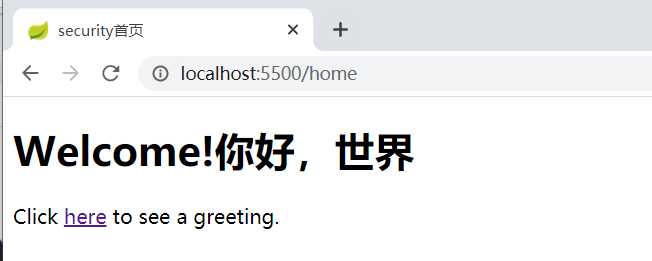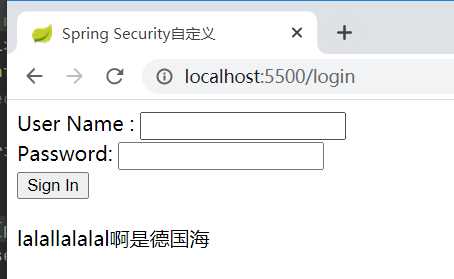spring boot + thymeleaf +security自定义规则 的简单使用
2020-12-27 19:29
标签:gif 属性 new login encode resolve star memory tco 以前开发一直使用 springMVC模式开发 ,前端页面常使用 JSP ,现在html5淘汰了 ,要么使用html ,要么使用vue , 现在使用spring boot ,有必要总结一下 spring boot 对html 的操作 。 spring boot 2.1.6.RELEASE (1)下载依赖 完整pom (2)目录结构 (3)resources 里的static包是存放静态资源的 ,static下面新建一个img包 ,里面放一个图片文件 启动后,直接输入网址 http://localhost:5500/img/xx.png 即可访问 ,不会被security拦截 【只要pom加了security依赖包 ,将默认启动security,默认账户名 为 user 密码是打印台打印的 随机数 】 (4)使用了thymeleaf 模板 ,那么html文件必须放在 路径为 resources/templates 的文件夹里面 否则spring boot 扫描不到文件 ,当然,也是可以修改的需要在application配置文件里修改 完整的pom.xml (5)新建html文件 新建一个名为 index.html的文件 ,使用了 thymeleaf 模板的语法 th:href="@{/home}" 进行跳转 ,这个 /home路径是虚拟路径 ,需要设置的,待会展示 新建一个名为 home.html的文件 新建一个名为 hai.html的文件 新建一个名为 kk.html的文件,用于测试html文件获取静态文件 还需要新建一个login.html文件 ,待会用来作为security的自定义登录页面 (6)设置虚拟路径用于访问html文件 【springMVC的视图设置一样,但是,不需要配置,直接引入 thymeleaf 即可使用】 在controller层 (7)测试 启动类没有改变 ,默认即可 启动程序,访问 http://localhost:5500/ 将会弹出security页面 输入默认账户和密码 即可跳转index.html页面 点击 “我” ,可跳转到home.html页面 【注意 ,必须配置好了 html文件的虚拟路径 thymeleaf 模板语法 才可以使用,否则提示404 】 好了,到了这里已经完整的解释了 spring boot 怎么使用html作为前端页面开发 (8)修改security的拦截规则 新建 文件 WebSecurityConfig 源码 再次启动工程 访问 http://localhost:5500/ 可直接进入页面了 ,不需要security 验证 访问 http://localhost:5500/hai 会被security拦截 ,将进入配置的自定义登录页面 登录后才可以跳转 hai.html (9)登出 登出 security 网址访问 http://localhost:5500/login?logout ,点击蓝色大按钮即可 (1)方法一 : application配置文件添加属性 完整源码 (2)方法二: 进入刚才配置security规则的文件 WebSecurityConfig ,直接将用户设置在内存中 完整源码 (3)方法三: 仍然是修改 配置security规则的文件 WebSecurityConfig 完整源码 【注意: 三个方法任选一个都可以修改登录账号密码,但是,方法2和3不能同时使用 ,如果WebSecurityConfig 和application 文件 都写上 ,会导致application配置文件设置的账号密码失效,仅WebSecurityConfig内的方法设置的有效】 spring boot + thymeleaf +security自定义规则 的简单使用 标签:gif 属性 new login encode resolve star memory tco 原文地址:https://www.cnblogs.com/c2g5201314/p/13030335.html1.前言
2.环境
3.操作








spring.application.name=security-5500
# 应用服务web访问端口
server.port=5500
#配置security登录账户密和密码 ,不配置则默认账户是user,密码是随机生成的字符串,打印在启动栏中
#spring.security.user.name=11
#spring.security.user.password=22
#
##
##
##
## Enable template caching.
#spring.thymeleaf.cache=true
## Check that the templates location exists.
#spring.thymeleaf.check-template-location=true
## Content-Type value.
##spring.thymeleaf.content-type=text/html
## Enable MVC Thymeleaf view resolution.
#spring.thymeleaf.enabled=true
## Template encoding.
#spring.thymeleaf.encoding=utf-8
## Comma-separated list of view names that should be excluded from resolution.
#spring.thymeleaf.excluded-view-names=
## Template mode to be applied to templates. See also StandardTemplateModeHandlers.
#spring.thymeleaf.mode=HTML5
## Prefix that gets prepended to view names when building a URL.
##设置html文件位置
#spring.thymeleaf.prefix=classpath:/templates/
## Suffix that gets appended to view names when building a URL.
#spring.thymeleaf.suffix=.html spring.thymeleaf.template-resolver-order= # Order of the template resolver in the chain. spring.thymeleaf.view-names= # Comma-separated list of view names that can be resolved.
DOCTYPE html>
html lang="zh" xmlns="http://www.w3.org/1999/xhtml"
xmlns:th="http://www.thymeleaf.org" xmlns:sec="http://www.thymeleaf.org/thymeleaf-extras-springsecurity3">
head>
meta charset="UTF-8">
title>indextitle>
head>
body>
你好 ,世界 ,2333
p>点击 a th:href="@{/home}">我a> 去home.html页面p>
body>
html>
DOCTYPE html>
html lang="zh" xmlns="http://www.w3.org/1999/xhtml"
xmlns:th="http://www.thymeleaf.org" xmlns:sec="http://www.thymeleaf.org/thymeleaf-extras-springsecurity3">
head>
meta charset="UTF-8">
title>security首页title>
head>
body>
h1>Welcome!你好,世界h1>
p>Click a th:href="@{/hai}">herea> to see a greeting.p>
body>
html>
DOCTYPE html>
html lang="zh" xmlns="http://www.w3.org/1999/xhtml"
xmlns:th="http://www.thymeleaf.org" xmlns:sec="http://www.thymeleaf.org/thymeleaf-extras-springsecurity3">
head>
meta charset="UTF-8">
title>hai文件title>
head>
body>
你好呀世界,成功登录进来了
body>
html>
DOCTYPE html>
html lang="en">
head>
meta charset="UTF-8">
title>kktitle>
head>
body>
img src="img/xx.png" alt="">
body>
html>
DOCTYPE html>
html xmlns="http://www.w3.org/1999/xhtml" xmlns:th="http://www.thymeleaf.org"
xmlns:sec="http://www.thymeleaf.org/thymeleaf-extras-springsecurity3">
head>
title>Spring Security自定义title>
head>
body>
div th:if="${param.error}">
Invalid username and password.
div>
div th:if="${param.logout}">
You have been logged out.
div>
form th:action="@{/login}" method="post">
div>label> User Name : input type="text" name="username"/> label>div>
div>label> Password: input type="password" name="password"/> label>div>
div>input type="submit" value="Sign In"/>div>
form>
br>
lalallalalal啊是德国海
body>
html>
package com.example.security5500.controller;
import org.springframework.stereotype.Controller;
import org.springframework.web.bind.annotation.RequestMapping;
import org.springframework.web.bind.annotation.RestController;
import org.springframework.web.servlet.ModelAndView;
@Controller
public class MVCController {
@RequestMapping("/home")
public String home() {
return "home";
}
@RequestMapping("/login")
public String login(){
return "login";
}
@RequestMapping("/hai")
public String hai() {
return "hai";
}
@RequestMapping("/")
public String index() {
return "index";
}
@RequestMapping("kk")
public String kk() {
return "kk";
}
//心得,index.html默认是首页,当没有指定路径 / 是哪个文件时 index.html将默认是根路径/
}







package com.example.security5500.securityConfig;
import org.springframework.beans.factory.annotation.Autowired;
import org.springframework.context.annotation.Bean;
import org.springframework.context.annotation.Configuration;
import org.springframework.security.config.annotation.authentication.builders.AuthenticationManagerBuilder;
import org.springframework.security.config.annotation.web.builders.HttpSecurity;
import org.springframework.security.config.annotation.web.configuration.WebSecurityConfigurerAdapter;
import org.springframework.security.config.annotation.web.configuration.EnableWebSecurity;
@Configuration
@EnableWebSecurity
public class WebSecurityConfig extends WebSecurityConfigurerAdapter {
//定义了哪些URL路径应该被保护,哪些不应该。具体来说,“/”和“/ home”路径被配置为不需要任何身份验证。所有其他路径必须经过身份验证。
@Override
protected void configure(HttpSecurity http) throws Exception {
http
//设置不拦截页面,可直接通过,路径访问 "/", "/index", "/home" 则不拦截
.authorizeRequests()
.antMatchers("/", "/index", "/home").permitAll()
.anyRequest().authenticated()
.and()
//设置自定义登录页面
.formLogin()
.loginPage("/login")
.permitAll()
.and()
//设置自定义登出页面
.logout()
// .logoutUrl("/mylogout")
.permitAll();
}
}



4.如何修改security的账户与密码?
#配置security登录账户密和密码 ,不配置则默认账户是user,密码是随机生成的字符串,打印在启动栏中
spring.security.user.name=11
spring.security.user.password=22


spring.application.name=security-5500
# 应用服务web访问端口
server.port=5500
#配置security登录账户密和密码 ,不配置则默认账户是user,密码是随机生成的字符串,打印在启动栏中
spring.security.user.name=11
spring.security.user.password=22
#
##
##
##
## Enable template caching.
#spring.thymeleaf.cache=true
## Check that the templates location exists.
#spring.thymeleaf.check-template-location=true
## Content-Type value.
##spring.thymeleaf.content-type=text/html
## Enable MVC Thymeleaf view resolution.
#spring.thymeleaf.enabled=true
## Template encoding.
#spring.thymeleaf.encoding=utf-8
## Comma-separated list of view names that should be excluded from resolution.
#spring.thymeleaf.excluded-view-names=
## Template mode to be applied to templates. See also StandardTemplateModeHandlers.
#spring.thymeleaf.mode=HTML5
## Prefix that gets prepended to view names when building a URL.
##设置html文件位置
#spring.thymeleaf.prefix=classpath:/templates/
## Suffix that gets appended to view names when building a URL.
#spring.thymeleaf.suffix=.html spring.thymeleaf.template-resolver-order= # Order of the template resolver in the chain. spring.thymeleaf.view-names= # Comma-separated list of view names that can be resolved.
//将单个用户设置在内存中 ,在这里设置了用户信息,那么application的登录信息则不需要写
@Bean
@Override
protected UserDetailsService userDetailsService() {
PasswordEncoder encoder = PasswordEncoderFactories.createDelegatingPasswordEncoder();
UserDetails user = User
.withUsername("user")
.password(encoder.encode("11"))
.roles("USER")
.build();
return new InMemoryUserDetailsManager(user);
}


package com.example.security5500.securityConfig;
import org.springframework.beans.factory.annotation.Autowired;
import org.springframework.context.annotation.Bean;
import org.springframework.context.annotation.Configuration;
import org.springframework.security.config.annotation.authentication.builders.AuthenticationManagerBuilder;
import org.springframework.security.config.annotation.web.builders.HttpSecurity;
import org.springframework.security.config.annotation.web.configuration.WebSecurityConfigurerAdapter;
import org.springframework.security.config.annotation.web.configuration.EnableWebSecurity;
import org.springframework.security.core.userdetails.User;
import org.springframework.security.core.userdetails.UserDetails;
import org.springframework.security.core.userdetails.UserDetailsService;
import org.springframework.security.crypto.factory.PasswordEncoderFactories;
import org.springframework.security.crypto.password.PasswordEncoder;
import org.springframework.security.provisioning.InMemoryUserDetailsManager;
@Configuration
@EnableWebSecurity
public class WebSecurityConfig extends WebSecurityConfigurerAdapter {
//定义了哪些URL路径应该被保护,哪些不应该。具体来说,“/”和“/ home”路径被配置为不需要任何身份验证。所有其他路径必须经过身份验证。
@Override
protected void configure(HttpSecurity http) throws Exception {
http
//设置不拦截页面,可直接通过,路径访问 "/", "/index", "/home" 则不拦截
.authorizeRequests()
.antMatchers("/", "/index", "/home").permitAll()
.anyRequest().authenticated()
.and()
//设置自定义登录页面
.formLogin()
.loginPage("/login")
.permitAll()
.and()
//设置自定义登出页面
.logout()
// .logoutUrl("/mylogout")
.permitAll();
}
//将单个用户设置在内存中 ,在这里设置了用户信息,那么application的登录信息则不需要写
@Bean
@Override
protected UserDetailsService userDetailsService() {
PasswordEncoder encoder = PasswordEncoderFactories.createDelegatingPasswordEncoder();
UserDetails user = User
.withUsername("user")
.password(encoder.encode("11"))
.roles("USER")
.build();
return new InMemoryUserDetailsManager(user);
}
}
//可以使用以下配置在内存中进行注册公开内存的身份验证{@link UserDetailsService}:
// 在内存中添加 user 和 admin 用户
@Override
protected void configure(AuthenticationManagerBuilder auth) throws Exception {
auth
.inMemoryAuthentication().withUser("user").password("11").roles("USER").and()
.withUser("admin").password("11").roles("USER", "ADMIN");
}
// 将 UserDetailsService 显示为 Bean
@Bean
@Override
public UserDetailsService userDetailsServiceBean() throws Exception {
return super.userDetailsServiceBean();
}
@Bean
public static NoOpPasswordEncoder passwordEncoder() {
return (NoOpPasswordEncoder) NoOpPasswordEncoder.getInstance();
}


package com.example.security5500.securityConfig;
import org.springframework.beans.factory.annotation.Autowired;
import org.springframework.context.annotation.Bean;
import org.springframework.context.annotation.Configuration;
import org.springframework.security.config.annotation.authentication.builders.AuthenticationManagerBuilder;
import org.springframework.security.config.annotation.web.builders.HttpSecurity;
import org.springframework.security.config.annotation.web.configuration.WebSecurityConfigurerAdapter;
import org.springframework.security.config.annotation.web.configuration.EnableWebSecurity;
import org.springframework.security.core.userdetails.User;
import org.springframework.security.core.userdetails.UserDetails;
import org.springframework.security.core.userdetails.UserDetailsService;
import org.springframework.security.crypto.factory.PasswordEncoderFactories;
import org.springframework.security.crypto.password.NoOpPasswordEncoder;
import org.springframework.security.crypto.password.PasswordEncoder;
import org.springframework.security.provisioning.InMemoryUserDetailsManager;
@Configuration
@EnableWebSecurity
public class WebSecurityConfig extends WebSecurityConfigurerAdapter {
//定义了哪些URL路径应该被保护,哪些不应该。具体来说,“/”和“/ home”路径被配置为不需要任何身份验证。所有其他路径必须经过身份验证。
@Override
protected void configure(HttpSecurity http) throws Exception {
http
.authorizeRequests()
//设置不拦截页面,可直接通过,路径访问 "/", "/index", "/home" 则不拦截
.antMatchers("/", "/index", "/home").permitAll()
.anyRequest().authenticated()
.and()
//设置自定义登录页面
.formLogin()
.loginPage("/login")
.permitAll()
.and()
//设置自定义登出页面
.logout()
// .logoutUrl("/mylogout")
.permitAll();
}
//可以使用以下配置在内存中进行注册公开内存的身份验证{@link UserDetailsService}:
// 在内存中添加 user 和 admin 用户
@Override
protected void configure(AuthenticationManagerBuilder auth) throws Exception {
auth
.inMemoryAuthentication().withUser("user").password("11").roles("USER").and()
.withUser("admin").password("11").roles("USER", "ADMIN");
}
// 将 UserDetailsService 显示为 Bean
@Bean
@Override
public UserDetailsService userDetailsServiceBean() throws Exception {
return super.userDetailsServiceBean();
}
@Bean
public static NoOpPasswordEncoder passwordEncoder() {
return (NoOpPasswordEncoder) NoOpPasswordEncoder.getInstance();
}
}
上一篇:js 数组对象去重
下一篇:springmvc文件上传
文章标题:spring boot + thymeleaf +security自定义规则 的简单使用
文章链接:http://soscw.com/index.php/essay/38658.html